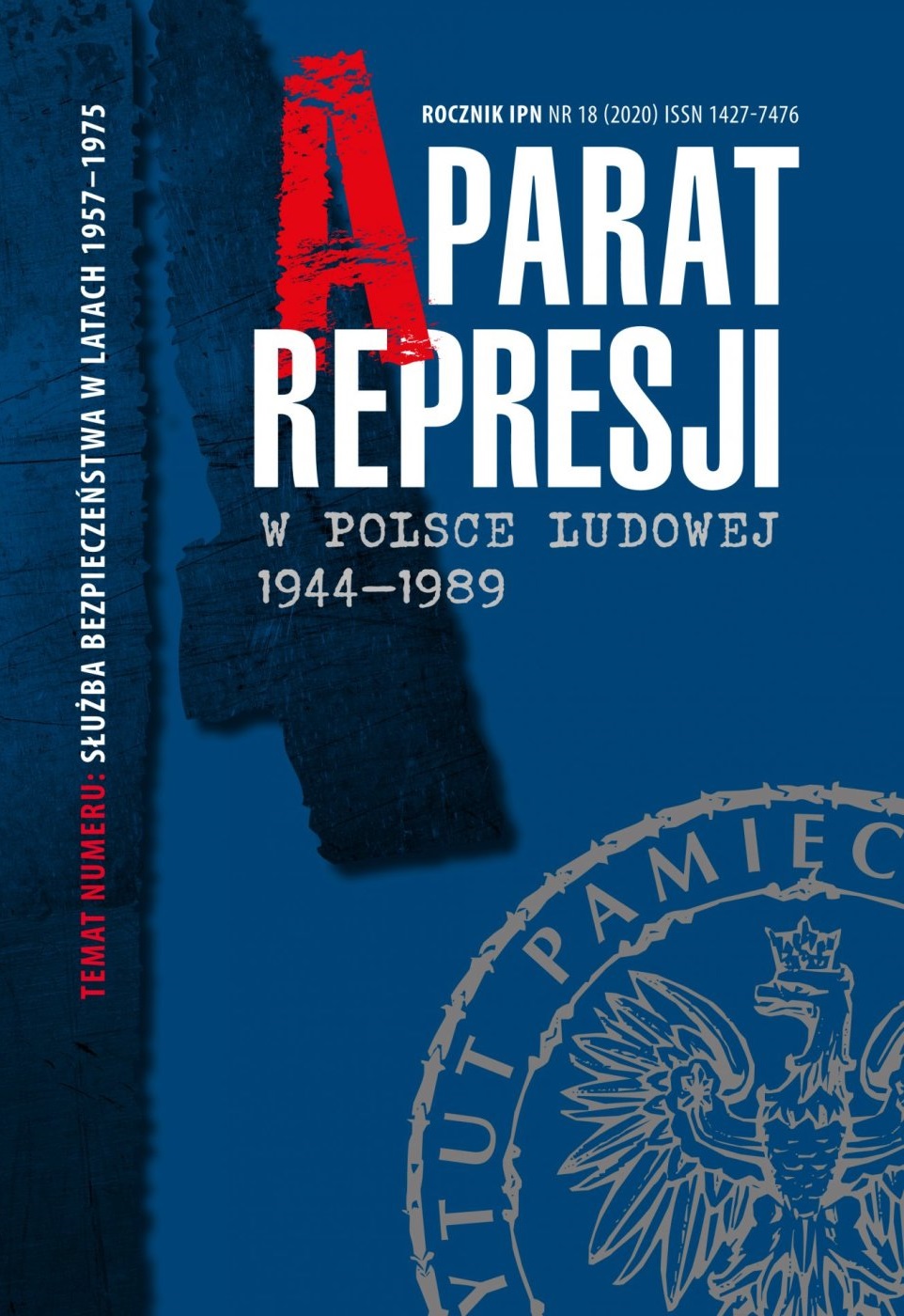Division II of the Security Services and the Federal Republic of Germany, the German Population, Pro-German Attitudes and Polish-German Relations: A Case Study of Upper Silesia in 1957–1990
Aparat Represji w Polsce Ludowej 1944-1989, No. 18 (2020), pages: 71-97
Publication date: 2023-03-29
 https://doi.org/10.48261/ARPRL201804
https://doi.org/10.48261/ARPRL201804
Abstract
One of the most important tasks of the security apparatus in Poland’s Upper Silesia involved combating German identity or pro-German sentiment among the local Silesian population. This effort was predominantly aimed at protecting the European territorial status quo after World War II. Also, or perhaps predominantly, the security apparatus was involved in efforts to safeguard the interests of Communist power, which aspired to maintain complete control over society. This control was seen as a tool for implementing a utopian vision of a society that was fully homogeneous in terms of ideology, politics or ethnicity. This political ambiguity was particularly characteristic of the counterintelligence elements of the Security Services, known as Division II (pion II), tasked with the so-called ‘German issues’. Out of all the structures in the Security Services, that section’s tasks were the most closely aligned with Poland’s national interests. However, it would be a serious mistake to overlook the section’s other tasks, which were predominantly aimed at destroying social liberties and implementing the totalitarian aspirations of Communist power.
Keywords
Służba Bezpieczeństwa • kontrwywiad • pion II • Niemcy • Górny Śląsk Security Services (Poland) • counterintelligence • Division II • Germany • Upper Silesia
References
Archiwum Instytutu Pamięci Narodowej w Warszawie (AIPN)
Archiwum Instytutu Pamięci Narodowej Oddział w Katowicach (AIPN Ka)
Archiwum Instytutu Pamięci Narodowej Oddział we Wrocławiu (AIPN Wr)
Instrukcje o pracy operacyjnej aparatu bezpieczeństwa (1945–1989), wstęp i oprac. T. Ruzikowski, Warszawa 2004
Aparat bezpieczeństwa w Polsce. Kadra kierownicza, t. 2: 1956–1975, red. nauk. P. Piotrowski, Warszawa 2006
Aparat bezpieczeństwa w Polsce. Kadra kierownicza, t. 3: 1975–1990, red. nauk. P. Piotrowski, Warszawa 2008
Bereszyński Z., Instytut Śląski w Opolu w krzywym zwierciadle doniesień tajnego współpracownika ps. „Jan” [w:] Granice kompromisu. Naukowcy wobec aparatu władzy ludowej, red. P. Franaszek, Warszawa 2015, s. 145–169.
Bereszyński Z., Komunistyczny aparat bezpieczeństwa i ludność niemiecka na Górnym Śląsku w latach 1945–1990, wyd. 2, Opole–Gliwice 2019
Dominiczak H., Organy bezpieczeństwa PRL 1944–1990, Warszawa 1997
Hermański M., Jusupović A., Wróblewski T., Cywilne organy bezpieczeństwa państwa 1956–1990 [w:] Historyczno-prawna analiza struktur organów bezpieczeństwa państwa w Polsce Ludowej (1944–1990). Zbiór studiów, red. A. Jusupović, R. Leśkiewicz, Warszawa 2013, s. 111–150
Holona E., Dr Stanisław Michalak (1933–2007),"Indeks. Pismo Uniwersytetu Opolskiego" 2007, nr 5–6, s. 81
Lis M., Historia PIN – Instytutu Śląskiego w Opolu, Państwowy Instytut Naukowy – Instytut Śląski w Opolu, https://instytutslaski.pl/historia-instytutu-slaskiego/, dostęp 10 X 2020 r.
Maziarz A., Zarys dziejów katedr i zakładów [w:] Półwiecze Katedry i Zakłady Instytutu Historii w latach 1957–2007, red. J. Dorobisz, Opole 2007
Piotrowski P., Struktury Służby Bezpieczeństwa MSW 1975–1990, „Pamięć i Sprawiedliwość” 2003, nr 1, s. 51–107
Sypko B., Stefan Oswald Popiołek (1926–1986) i jego zasługi dla Opola [w:] Opolanie znani i nieznani. Czasy po II wojnie światowej. Część 1, Opole 2017, red. M. Świder, s. 233–253
Terlecki R., Miecz i tarcza komunizmu. Historia aparatu bezpieczeństwa w Polsce 1944–1990, Kraków 2007
License

This work is licensed under a Creative Commons Attribution-NonCommercial-NoDerivatives 4.0 International License.
https://creativecommons.org/licenses/by-nc-nd/4.0
Most read articles by the same author(s)
- Zbigniew Bereszyński, Organisational and Staff Capacity and the Major Directions of Security Service Activity in the Opole Province during 1975-1990 (Part I) , Aparat Represji w Polsce Ludowej 1944-1989: No. 20 (2022)
- Zbigniew Bereszyński, [Review] Tomasz Kozłowski, Koniec imperium MSW. Transformacja organów bezpieczeństwa państwa 1989–1990, Warsaw, 2019 , Aparat Represji w Polsce Ludowej 1944-1989: No. 18 (2020)
- Zbigniew Bereszyński, Recruitment, training and careers of the Security Service officers based on the example of the Opolskie Voivodeship , Aparat Represji w Polsce Ludowej 1944-1989: No. 1(15) (2017)
- Zbigniew Bereszyński, Organisational and Staff Capacity and the Major Directions of Security Service Activity in the Opole Province during 1975–1990 (Part II) , Aparat Represji w Polsce Ludowej 1944-1989: No. 21 (2023)
- Zbigniew Bereszyński, Okrągły stół i zmiany w postawie SB wobec „Solidarności”. Uwagi na marginesie publikacji Służba Bezpieczeństwa wobec przemian politycznych w latach 1988–1990. Region łódzki , Aparat Represji w Polsce Ludowej 1944-1989: No. 1(8-9) (2011)
- Zbigniew Bereszyński, Criminal and disciplinary Liability of Security Office, Security Service and Citizens Militia in the light of documented examples from Opole Selesia , Aparat Represji w Polsce Ludowej 1944-1989: No. 1(16) (2018)
- Zbigniew Bereszyński, The Security Service and Scientific Communities. Relationships between Scientists and the Repressive Apparatus as illustrated with the Example of Opole , Aparat Represji w Polsce Ludowej 1944-1989: No. 1(12) (2014)
- Zbigniew Bereszyński, Staff of the security apparatus, with particular emphasis on managerial posts in Opole Voivodship between 1956–1990 , Aparat Represji w Polsce Ludowej 1944-1989: No. 1(14) (2016)
- Zbigniew Bereszyński, Grzegorz Kowal, The Retreat Center in Grodków (1981–1982), Wrocław 2013 , Aparat Represji w Polsce Ludowej 1944-1989: No. 1(14) (2016)
 Język Polski
Język Polski
 English
English



 PDF (Język Polski)
PDF (Język Polski)
